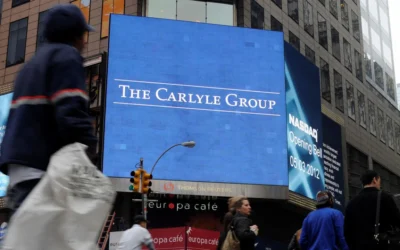Implicit in these predictions is a conviction: private equity’s strong secular growth won’t be derailed by the vagaries of the next few economic cycles. Predicting, of course, is hit-and-miss, particularly when you’re looking 10 years out. Please don’t blame me if I get a few of these wrong.
2029-P1: The Value of Private Equity Assets Rises to $30 Trillion
The assets under management of private equity broadly defined, encompassing buyout, credit, growth, real asset and venture capital strategies, stand at $30 trillion, up from $5.8 trillion in 2019, a more than five-fold increase in a decade. As private equity financing encroached on global stock markets, the latter’s capitalization grew more slowly, increasing to $156 trillion from $90 trillion over a decade – less than a two-fold increase. The foundation of private equity’s stunning secular growth since its post-World War II beginnings is the credible promise of double-digit returns, achieved through activist ownership (contrasted with the passive ownership that characterizes public equity markets). While very large private equity funds may see their returns decline as a lines blur with listed equity, new incarnations of PE promising the same stellar returns as those of the past are still very much part of the scene in 2029.
2029-P2: Volume for PE Funds Sold on the Secondary Market Hits $1.5 Trillion
Secondary volume in 2029 comes in at some $1.5 trillion, representing a nearly 17-fold increase from the $90 billion recorded in 2019. The growth of the secondary market since 2008’s global financial crisis, when funds sold between investors generated annual turnover of only $8 billion, has been a key catalyst of the asset category’s overall expansion. The ability to resell has turned an illiquid asset class into a liquid one, attracting investors of all types.
2029-P3: Retail Investors Worldwide Invest in Private Equity
With wealth thresholds on private placement investment largely eliminated by regulators over the course of the 2020s, retail investors throughout the world buy private equity funds, pursuing a diverse range of buyout, credit, growth, real asset and venture capital strategies.
2029-P4: Low-Fee Super-Mega-Funds Are Everywhere
Super-mega-funds – private equity investment vehicles with $50 billion or more in assets under management – dominate PE. These funds use artificial intelligence to identify promising investments. They charge annual fees of 0.25-to-0.50 percent (versus an industry average of 2 percent in 2019). Carry (profit sharing) averages 2.5 percent across the super-megas. The preferred return hurdle for investors that once triggered carry for managers no longer exists (this hurdle averaged 8 percent in 2019). Investors in private equity’s biggest funds are mostly very large institutions (with $30-to-$70 billion in assets under management) or retail investors with less than $1 million in total assets.
2029-P5: The Biggest Funds Invest in Both Public and Private Markets
The largest super-megas (see P4) in 2029 are hybrids and have assets under management in excess of $100 billion. They invest heavily in both public and private markets. Indeed, the top-ranked super-mega with more than $300 billion in AUM is the Fidelity Magellan fund. With just $16 billion in AUM in 2019 and overwhelmingly focused on listed equity, Fidelity Magellan now has 45 percent of its assets in private equity broadly defined.
2029-P6: Mergers and Acquisitions Radically Alter Private Equity
In addition to superior returns, the growth of the secondary market, and retail investment in private equity, another key factor behind industry expansion is the wave of consolidation sweeping through PE in the 2020s; most major players in traditional asset management either bought or merged with large private equity managers as a way to combat falling profits tied to low-margin stock index funds. Over a decade, profits for most forms of fund management have dropped, but they’ve fallen the most for index funds.
2029-P7: Small(ish) Funds are PE’s Classic-Tier (read high margin funds)
With the super-megas stripped out (see P4), average private equity fund size is $5 billion. That’s a 5-fold increase over 2019. Compared with 2019, there are more funds with commitments in excess of $20 billion, but there are also many more with commitments of $200 million or less. What unites private equity’s diverse classic-tier – funds of less than $50 billion – is a way of operating that’s changed little in a decade. These funds rely heavily on human judgement, not artificial intelligence. Many are also specialists, focusing on niches like healthcare or online retailing. They charge annual fees of 1.5-to-2.0 percent while carry – profit sharing – is set at 20 percent of gains, after an 8 percent preferred return for investors (just like in 2019). Investors look for low-risk beta when investing in the super-megas, and outperformance, or alpha, from the classic-tier. Classic-tier funds mostly belong to tightly held private partnerships; given fee levels, these partnerships produce a disproportionate share of the world’s billionaires.
2029-P8: PE is Subject to Two Regulatory Regimes in Most Places
In most areas of the world, regulators use two different regimes for the two broad types of private equity that have developed over the last decade, super-mega funds (see P4) and classic-tier funds (see P7). Following more demanding rules than smaller funds, private equity vehicles raising approximately $50 billion or more from investors (the exact amount varies by regulator) must publicly disclose standardized metrics for private market investments, including debt and equity valuations for portfolio companies, on a quarterly basis. Smaller funds are exempt from the stringent rules, but their investors must pass financial market knowledge exams and qualify as sophisticated investors (wealth thresholds for PE investment no longer exist – see P3).
2029-P9: Longer-Term PE Funds Are an Industry Mainstay
Investment lives extending well beyond the 10 years that once typified private equity funds are now highly common. Roughly two dozen funds, each with assets of $30 billion or more, have investment lives of 50 years (at least a quarter century longer than any existing fund in 2019). These funds typically acquire both majority and minority stakes and target companies with strong competitive moats that they believe can produce at least a 20 percent annual return on equity. The funds buy in instances – much more frequent in 2029 than a decade earlier – where managements want to remain private indefinitely.
2029-P10: Impact Investing Tackles Seemingly Intractable Problems
Private equity impact investment programs devoted to “solutions to intractable problems” (STIPs) are increasingly common. STIPs cover investment in fields such as cancer, neurodegenerative disease and climate change, where public markets and listed companies (because of short-termism) have proven incapable of funding long-term profitable solutions. As evidenced by the valuations of successive investment rounds, the best of these funds – STIPs still have a long road to maturity – deliver the 10x-plus returns once associated only with early-stage venture capital funds.
Source: Forbes
Can’t stop reading? Read more
Carlyle and Goldman Sachs open private credit funds to Willow users with $10,000 minimum
Carlyle and Goldman Sachs open private credit funds to Willow users with $10,000 minimum Carlyle,...
EQT, PAI, and Stone Point shortlisted for €2bn takeover of Castik-backed Global Group
EQT, PAI, and Stone Point shortlisted for €2bn takeover of Castik-backed Global Group EQT, PAI...
CAIS Advisors unveils retail vehicle giving investors a stake in elite sports and media
CAIS Advisors unveils retail vehicle giving investors a stake in elite sports and media Eldridge...




